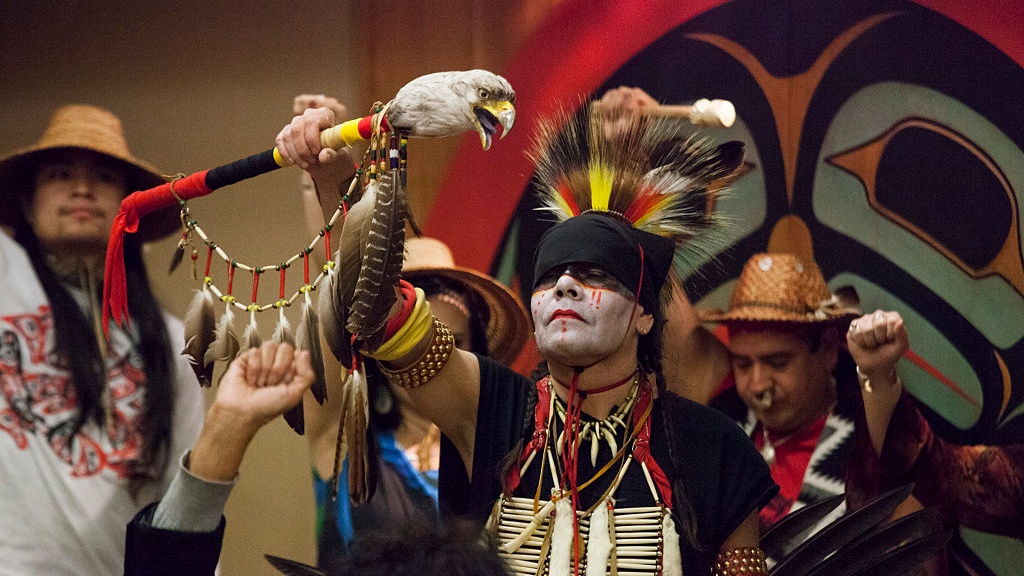Indigenous Peoples’ Day has quickly taken over for Columbus Day in many parts of the United States in the past few years.
According to Smithsonian Magazine, there are now 14 states, 130 cities and hundreds of schools across the country that have pivoted to focusing on Indigenous communities and history instead of Columbus Day. The states now celebrating Indigenous Peoples’ Day include Alabama, Alaska, Hawaii, Idaho, Maine, Michigan, Minnesota, New Mexico, North Carolina, Oklahoma, Oregon, South Dakota, Vermont and Wisconsin as well as the District of Columbia.
The Southern Poverty Law Center notes that wildly enough, Indigenous Americans weren't granted U.S. citizenship until 1924 and restricted from voting until 1948.
Indigenous communities still face racism and overwhelmingly discriminatory practices related to things like healthcare and self-government. Like Black communities, Native populations have also been hit hard by COVID-19, with extraordinarily high rates of contraction and death during the pandemic, as Blavity previously reported.
"The Navajo Nation is in a crisis with cases, and there are tribes and other Indian organizations across the country that are in similar crises and can use medical supplies and help instead of watching people die. This is a metaphor for what's happening," Abigail Echo-Hawk, the Seattle Indian Health Board's CFO, told NBC News earlier this year.
In honor of Indigenous Peoples’ Day, here are some ways you can support Indigenous Communities.
1. Read Indigenous Writers
Renée Gokey, the teacher services coordinator at the Smithsonian’s National Museum of the American Indian in Washington, D.C., wrote in an article that one of the best ways people can support Native communities is by education yourself and reading more things from the perspective of Indigenous people.
Dr. Debbie Reese, founder and co-editor of American Indians in Children’s Literature, has created an exhaustive list of books for people of all ages about Native American communities.
"Choose books that are tribally specific (that name a specific tribal nation and accurately present that nation), written by Native writers, set in the present day, and relevant all year round, keeping Native peoples visible throughout the school year,” Reese said, according to PBS.
Amazon also created a list of Indigenous books people can buy to learn more about the community.
"Native American people speak of the seven generations, where decisions and actions taken today, must be considered for how they will impact the ones seven generations from now. To me, that's what these Indigenous authors represent," said Fawn Sanchez, Shoshone-Bannock and Carizzo-Comecrudo, AWS Training Manager and Vice President of Amazon’s Indigenous Affinity Group.
"Their experiences and beliefs come alive in a way that informs and educates others on our beautiful culture," they added.
2. Attend a virtual Indigenous Peoples' Day event
There are a number of events being held this year online to mark Indigenous Peoples’ Day. The Smithsonian’s National Museum of the American Indian is streaming an event at 1 p.m. on October 12 for students with webinars and discussions.
There will also be music and other presentations about the history of Indigenous communities.
Other events are planning to be held, like the Indigenous Peoples’ Day Convergence by the Greater Cincinnati Native American Coalition, which will take place virtually between October 10, 11, and 12.
3. Support social justice efforts geared toward Indigenous women
There has been widespread anger about violence perpetrated against Native American women and a spate of disappearances in the community, according to the Seattle Times.
There are websites with lists of resources for those looking to help with the problem. A wider movement, called Missing and Murdered Indigenous Women, has focused on the problem and sought help from authorities as well as other groups that have similar issues.
For decades, Native American women have suffered higher levels of abuse, violence and kidnapping. Despite appeals to local governments as well as federal officials in Canada and the United States, little has been done to address the violence against Native American women.
tw // murder
please take some time to read through this carrd and educate yourself on the crisis involving indigenous women, it also contains donation links, petitions and a list of indigenous creators to support!! #IndigenousPeoplesDay
https://t.co/qcFn6ZUuaP— rose ࿐ ˚ . ✦ | ANGC and HADGC day (@godappIes) October 12, 2020
There are also dozens of other adversities faced by Native Americans, including high levels of poverty, discrimination when it comes to employment and housing as well as continuing efforts by the government to keep control of Native land.
The U.S. Supreme Court in July ruled that significant parts of Oklahoma should be considered tribal territory, and in the ruling the court noted that dozens of treaties signed by the U.S. government were never honored after being agreed upon.
4. Plant something
Gokey explained that one of the best things people can do is to plant something native as a way to support the ecosystem.
"Consider the pawpaw, a native tree widely distributed in most of the United States and common east of the Mississippi. My tribe, the Shawnee, call this time of year when the pawpaw fruits ripen the pawpaw moon. Outside the Deep South, the pawpaw is the only host species for caterpillars of the zebra swallowtail butterfly," Gokey wrote.
"Think of the impact you can have by planting native species and returning health to your yard and neighborhood. The U.S. Forest Service has all sorts of resources about gardening with native species on its website Celebrating Wildflowers."

